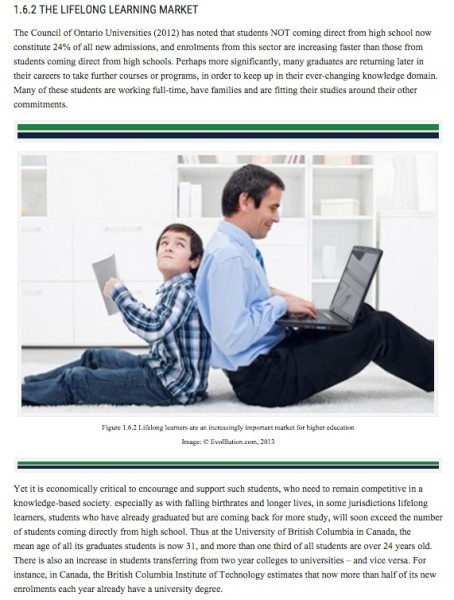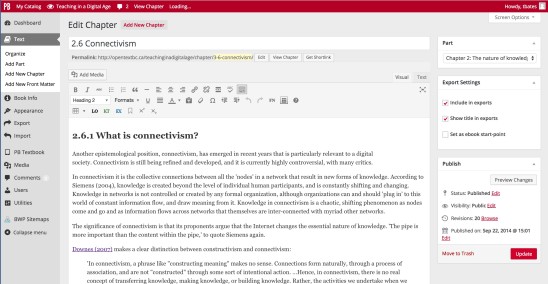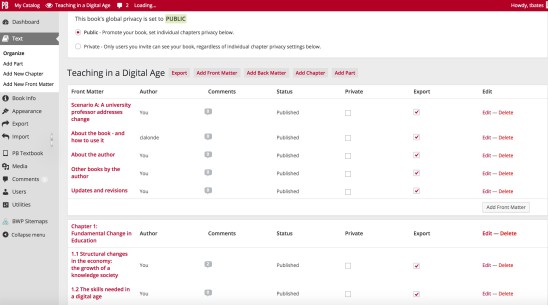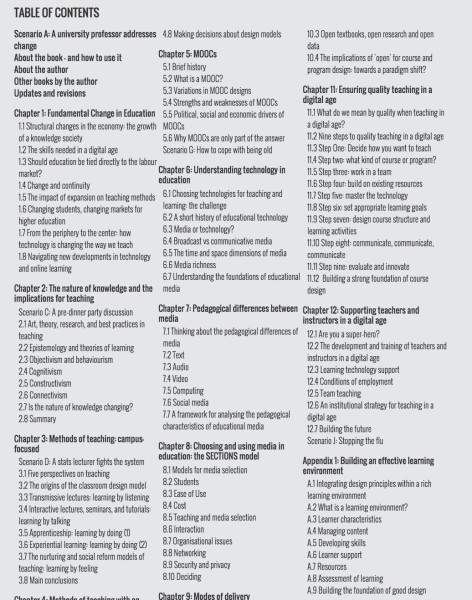Clik here to view.

Does it look like a textbook?
In earlier posts, I have discussed how to measure the success of an open, online textbook, Teaching in a Digital Age, and also discussed the costs of developing and writing the book. In this post I will look at what I learned from this activity, and will discuss whether it was worth it.
Why did I want to write an open textbook?
1. The need for change in teaching and learning
My main reason is that there is a major paradigm shift happening in education, driven partly by a changing economy and the need for a highly skilled and knowledgeable work-force, greater diversity of students as access has increased, and of course new technologies that not only have great capacity to change the way we teach, but which are also in common use by our students.
Although there are lots of articles and discussion about online, blended, hybrid, open learning and MOOCs, and too many books that exhort faculty and instructors to change, I felt (this muzzy, subjective word expresses well the intuitive rather than empirical basis for my view) that there wasn’t any other book ‘out there’ that really provided evidence-based, strong guidelines for faculty and instructors about how to teach in this volatile, uncertain, complex and ambiguous environment. At least writing the book and throwing it out there would test that idea.
If I was going to do that, though, I needed to practice what I preach, so it was important to design the book to embed some of the key principles and guidelines that I was extolling. An open textbook, easily accessible, technological, interactive, collaborative and dynamic, seemed a good way of doing this.
2. The BCcampus Open Textbook Project
A second reason is that right at my back door was this exciting, government-supported project for open textbooks. This provided me with the technology support and encouragement that I needed, as I had never written an open textbook before.
3. Giving back
This is the most difficult motivation for me to write about, so let me be frank. I’ve had a wonderful 40 year career in open and distance learning, earned good money by any standards, and I really believe in what I do as an open and distance educator. I don’t need the money from book royalties, I’ve already got 12 commercially published books behind me, and I’m at the end of my career, so I can afford the risk of it not working. So now is a good time to give something back.
Most important of all, there’s vanity (or is it narcissism?). Writing this book is a way to encapsulate all that I’ve learned in my career, and leave it, if I’m successful, in an easily accessible form for anyone who wants to make use of this experience – a sort of legacy project.
Perhaps most importantly, I believe knowledge – or at least academic knowledge – should be free and open to all. Why not the knowledge that I’ve acquired, for what it’s worth?
4. Testing the concept of open publishing
A big challenge is to get (other) authors to write an open textbook. There is no direct financial reward, and perhaps even more importantly, there is a much higher level of risk than going through commercial publishers. Who will read it? Will it be accepted in the academic community? Will it have as much influence? And a very practical question: how to do this? What do you need to know? Who can help you? How do you preserve the integrity of the book if people can just copy or alter what you’ve written? What will it cost?
I’m a researcher and evaluator by desire and training, so writing this book seemed to me to be a good way to examine and maybe stretch not only the technology of open textbooks, but the larger concepts and questions about open publishing. Hence this blog post, which is an interim report on the experiment. These motivations provide a framework for assessing the experience.
What did I learn?
I’ll start with the easiest question
1. The technology worked – mainly
I used the BCcampus version of Pressbooks, which is an open source, ‘simple book’ production software, built around WordPress. Thus anyone who has experience in blogging, particularly if they have used WordPress before, will find it very easy to use Pressbooks. I was literally writing within 10 minutes of opening the editing page.
BCcampus added a few extra features, such as edit boxes for learning outcomes, activities, and key takeaways from each chapter, that I was easily able to embed into the main text. BCcampus gave me a url for the editing and publishing and hosted the book on their server. There is a function, controlled by the author, that enables each part of the book to be private, or published on the open web site.
Clik here to view.

Figure 1: The Pressbooks editing page
I also wanted my book to be multi-media so it could easily demonstrate the value and appropriateness of different media for teaching. Importing graphics and podcasts is simple in Pressbooks, through the Add Media function. For video (as with most of the graphics) I use entirely copyright cleared material (i.e. OERs). I just provided a url to the site hosting the videos, with a graphic from the video where appropriate as the hot link. I created my own podcasts, using Apple’s Garage Band and a few graphics myself using Powerpoint. However, next time I would use a graphics designer from the beginning (see an earlier post on this) and get original graphics designed properly.
Second, it is easy to edit and re-structure the book, which I needed to do when I finished the first draft. I had to merge materials from different sections, split lengthy chapters into two or three separate chapters, move some parts earlier or later in the book, and make sure I had a consistent set of references throughput the book. This was all very easy to do, using the ‘Text/organise’ function, which allows you to drag and drop each section of the book.
Clik here to view.

Figure 2: Text/organise page
The most important feature of all though, which I did not get to appreciate until I had finished the book, is that as well as the html version that can be read online, Pressbooks exports the html version into a variety of formats for downloading, including pdf, epub, mobi, xhtml, and wxr, so it can be read on tablets and mobile phones as well as laptops. Creating these different versions is also extremely easy for an author to do, using the ‘export’ function in the text/organize page.
However, there were of course some unexpected technical problems that I ran into. Pressbooks confusingly uses the terms ‘parts’ and ‘chapters’ in a way that may suit novel writing, for which it was originally developed, but is not intuitive for a text book. The ‘parts’ function is really a header (like ‘Part One’ in a novel). I found that I could use the ‘Part’ function as a chapter heading and an advanced organizer, with learning outcomes, a brief list of chapter contents, and key takeaways/summary points, and the ‘Chapter’ function as ‘Sections’ of the chapter. This was critical, as research indicates most people spend a maximum of one hour on any particular chunk of academic reading, so I wanted to ensure that each section of a chapter was relatively short and could be covered within one hour. However, I was a third of the way through the book before I realised that I needed to reverse ‘chapter’ and ‘part’, so that ‘part’ was the header, and each ‘chapter’ was in fact a section of the chapter. (I should have followed my own advice, and read the Pressbook instructions before starting, but it is still not intuitive.)
The other, more serious, problem was exporting graphics into the different versions (pdf, epub, etc.), which I have discussed elsewhere. This is a problem on which I am still working.
Lastly I ran into a problem that most bloggers face at some time or another, persistent hacking attacks on the site, which required a lot of help from BCcampus technical support to manage. However, the public version of the book was never compromised.
Overall, though, the technology worked wonderfully well and should not stop any technology neophyte from writing an open textbook, although as always, good technical support is a necessary back-up when problems do occur.
2. Textbook or course?
One conceptual issue I kept running into was whether I was writing a textbook or a course. It’s important to realise that Pressbooks is NOT a learning management system, and does not come with all the functions of an LMS. For instance, although there is a comment function available at the end of each section of a chapter (as in blogs), this is not an adequate tool for discussion, compared with a threaded discussion forum in an LMS.
I wanted to incorporate a threaded discussion tool into the book, but there were two problems, one minor, one major. The minor problem was my inability to find a suitable open source, secure, password protected online discussion forum that I could integrate into Pressbooks. It’s a minor problem, because there are probably such tools available, and if not, it wouldn’t be difficult to build one.
However, the major problem is conceptual. An open textbook, if successful, will be used in many ways, by many people. Thus you need a way of separating out discussion between different groups, so that Instructor A using the book has his or her own group of students and discussions separate from Instructor B using the book. The same issue arises with embedding tests or even activities.
I therefore had to step back then and design the book as an open resource, parts of which could be incorporated or linked to easily from within an existing learning management system or even some other range of tools, such as social media.
The nice thing about a Creative Commons-licensed text book is that instructors – or students – can go the other way, and embed parts of the book within their LMS or e-portfolios or other platforms for their learning. So the looser the technological and conceptual structure for the book, the easier it is for end users. Nevertheless, the book is not as interactive as I would like, although if I had more time, I could probably incorporate more tests, open-ended questions and maybe even some games or simulations to reinforce the writing.
3. Accessibility
This leads to another point, which comes back to my goals for the book. My main target group for the book are mainstream, subject discipline faculty and instructors who are very busy doing research and have relatively little time to become experts in teaching. I wanted therefore a book that was easily accessible, organized in such a way that faculty could find what they were looking for with one or two clicks of a mouse. Each section can be read in less than an hour, but the whole book hangs together as a coherent whole. If instructors wanted to go further or deeper, I added activities and further reading within the section.
The contents page on the first screen/page of the book enables this – just click on the topic and you’re in.
Clik here to view.

Figure 3: Pressbooks table of contents: one click to the topic
4. Independent peer reviews are still necessary
I used my blog to float drafts of each chapter to a wide community of practitioners in online course design and research, and had an instructional designer and a group of digital learning specialists at Ryerson University giving me detailed feedback as the book progressed.
I also published each chapter when it was ready, seeking comments from general readers, as the book progressed. I also have 12 other peer reviewed, commercial publications behind me.
Nevertheless, I still had graduate students writing to me saying that their supervisors did not want them using my book as a reference in their theses as the book was not peer reviewed. My initial reaction was to tell the supervisors to go to hell, but that wouldn’t help the students, who were all anxious to quote my work, so I have requested three independent peer reviews that will be published as an appendix to the book. These will be ready by the end of June.
Was it worth it?
Emphatically, yes, from my perspective:
- the book has been downloaded roughly 10,000 times within two months, and more importantly, the qualitative responses to the book through e-mails and comments indicate that I am reaching my main target audience (see Measuring the success of an open textbook for more details);
- although all the reviews are not yet in, the response to the contents of the book have been generally highly favourable;
- I have been able to practice what I preached; I was able to write the book mainly in the way I wanted as someone with an instructional design background;
- there does seem to have been a gap in the market which the book is filling;
- the technology does work, and even technologically-challenged authors will be able to use the technology easily;
- I was able to go from initial idea to final publication of the book in 15 months. I have had a publisher take that long from handover of the final draft to publishing. For a book of this kind, quick publishing is important otherwise it starts to look out of date, even if the main foundations do not change;
- open publishing offer many possible routes for getting the book known, and with a little effort by the author, open textbook marketing works far better than the usual pathetic marketing efforts of commercial publishers;
- the book is dynamic; I can continue to edit, change and update the book on an ongoing basis.
So I feel really good about it. However, this kind of publishing may not work for others. It may be too risky for someone early in their career to go the open publishing route, in terms of credibility or academic acceptance. Those not experienced in writing books probably need the support of a commercial publisher. If you are looking to make money from writing, this is definitely not the way to go, unless you have a very creative business model. The support of BCcampus was essential for me, and others may not have such support.
But if you have something important to write and want to get out to as many people as possible, then I strongly recommend open publishing. But I’m not doing another one for a while!
Audio recording
A 41 minute audio of the full presentation on ‘Why write an open textbook?’, given at the ETUG workshop at Simon Fraser University on June 4, 2015, can be downloaded from here.
Robert Martelacci also recorded a podcast interview with me about the book, which is available here